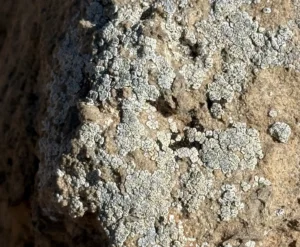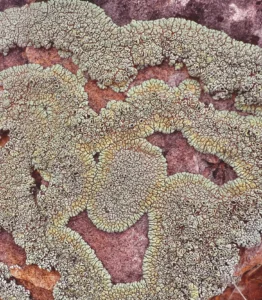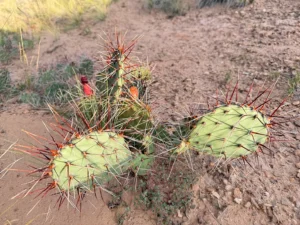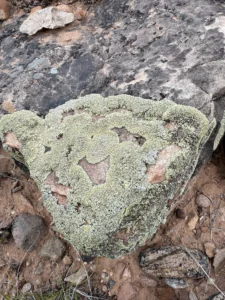OVERVIEW: The 8 day trip I took to Ghost Ranch for a “conscious eldering” workshop in mid-September was a milestone. It will take me a few posts just to scratch the surface. This is one of them.


I lament that my life has not been one of wide travel, so exposure to such a novel landscape was almost overwhelming. The first morning, I stepped away beyond the bunkhouse for my first true exploration of this alien place and I did not know a single plant by name. The bird calls were unknown. And the geology of the place was shockingly in my face.
The forest-draped shoulders of Blue Ridge mountains never showed me their bones in this way. I was a stranger in a strange land and found myself on a narrow spine of rock, slowly spinning, arms outstretched, to take it all in.
My gaze reached no further than the top inch of desert dust before I was enthralled and stopped in my tracks.

My first impression was that this high desert consisted of isolated almost-universally prickly plants widely separated by empty space of the bare ground between them.
While Appalachian forests are cool, green and shady and the plant life connected as a community by underground rootlets and fungal threads, there seems to be a kind of “every plant for himself” layout in the desert, with seemingly nothing in between.
But my first-morning closer look suggested the “empty space” idea was too quickly and mistakenly assigned.
The biocrust of deserts, of course is well known, but I had to discover it for myself.
THE PIONEERS
A living layer of life–the desert biocrust–occupies the “empty” space between cacti in many places. This thin and initially unnoticed film of life has been present and active in such a way that future soil was being created under my feet–as it has been by day, decade, century, and millennium.
- Details about the biocrust
-
- Indicator organism sensitive to air pollution
- Pioneer Organism
- Lichens of Southeast Utah (U.S. National Park Service)
Role of lichens
- Lichens of Southeast Utah (U.S. National Park Service)

I had intended to flesh this out quite a bit more but life interrupts. I wanted to begin to chip away at my notes from Ghost Ranch, and next time I should be able to expend more time and effort to elaborate than I am able to do this morning.
The next post will be likely be botanical, with the species below perhaps the only familiar greenery I encountered all week long. (Opuntia sp?)


 – Fred First is an author, naturalist, photographer watching Nature under siege since the first Earth Day. Cautiously hopeful. Writing to think it through. Thanks for joining me. Subscribe to My Substack
– Fred First is an author, naturalist, photographer watching Nature under siege since the first Earth Day. Cautiously hopeful. Writing to think it through. Thanks for joining me. Subscribe to My Substack 